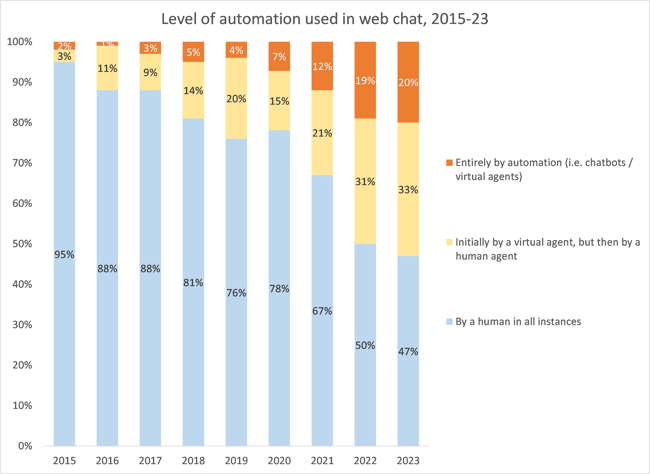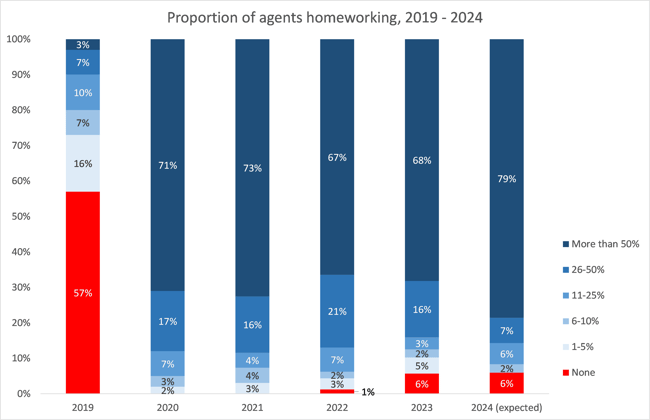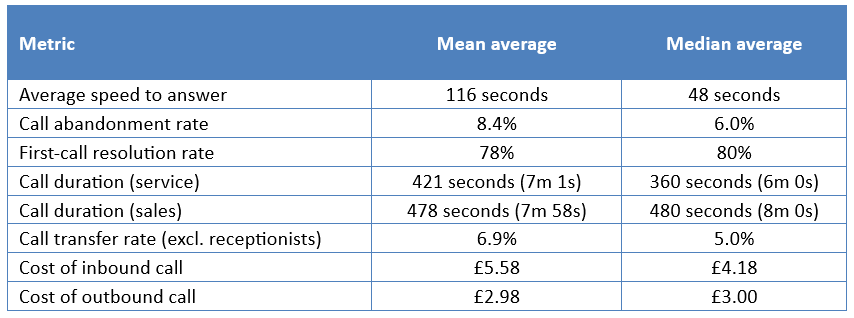UK Contact Centre Trends for 2024

By Steve Morrell, Managing Director at ContactBabel Ltd.
ContactBabel’s flagship report, “The 2024 UK Contact Centre Decision-Makers’ Guide”, is based on surveys with 225 UK organisations and 1,000+ interviews with UK consumers. This article looks at three of the key findings within the report: the rise in chatbots and their effect on cost, the future of remote contact centre working, and the crisis in contact centre performance.
THE RISE OF THE VIRTUAL AGENT
AI-enabled ‘Virtual Agents’ are increasingly common and may appear to a browsing website visitor to be a human agent offering web chat. However, it is an automated piece of software which looks at keywords and attempts to answer the customer’s request based on these, including sending relevant links, directing them to the correct part of the website or accessing the correct part of the knowledge base.
Whereas only 5% of web chats had any automation involved in 2015, this has grown to 53% in 2023, mainly as a result of initial handling by automated chatbots/virtual agents which may then hand off to live agents where appropriate, although fully automated AI-enabled web chat volumes have increased very significantly in recent years as well.
The increasing use of chatbots means that the mean average cost of a web chat is stated this year to be less than a phone call (£5.58) and an email (£3.55), and this differential is growing each year.

REMOTE WORKING – HERE TO STAY
The massive growth in remote working can be seen in the following chart: in 2019, 57% of respondents did not use any homeworking, a figure which dropped to zero in 2020 and remains very low today.
68% of operations now have more than half of their agents working at home at least some of the time, and there has been very little change in this in the past three years.
While this is in part likely to be a factor of the uncertainty surrounding the future, and may change once confidence in public health is re-established, there is certainly no rush amongst survey respondents to return to the centralised model. In fact, the expectation is that more agents will spend at least part of their time working at home.
Survey respondents were asked what their expectations of remote working are for 2024.
The proportion of agents working at home full-time is expected to be 23%, while 59% are expected to be hybrid workers. Only 8% of survey respondents expect all of their staff to be homeworking, and 6% expect all of their agents to be working in the contact centre.

CONTACT CENTRES UNDER PERFORMANCE PRESSURE
Understandably, the pandemic severely impacted the performance of most contact centres, but it is somewhat worrying that the industry as a whole shows little sign of returning to the performance levels it was maintaining before 2020.
Looking at the results of this year’s contact centre performance metrics:
- Average speed to answer has remained extremely high at 116 seconds, fuelled by the difficulties some contact centres are still having related to the pandemic and its after-effects, particularly in staffing. The median is also at a high level compared to historical data, suggesting that this is not being driven by a relatively small proportion of operations dragging the mean average upwards.
- Call abandonment rates have dropped slightly from 9.1% to 8.4%, but are still high in historic terms.
- Mean first-contact resolution rates remain quite steady.
- Mean service call duration remains close to its highest recorded level.
- Mean sales call duration drops slightly from its highest level – 516 seconds – to 478 seconds.
- Mean call transfer rate drops closer to the historically typical level.
- The mean and median costs of an inbound call are considerably higher than the typical average.
- Outbound call costs are a little lower than usual, but have hardly changed since 2017.

“The 2024 UK Contact Centre Decision-Makers’ Guide” is available to download here.
This article was originally published in Engage Magazine.


